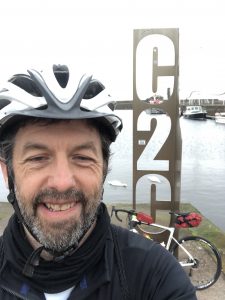Sustainability must scale
 I’m writing this in a half-asleep, constantly hungry state as I completed my big personal challenge for this year yesterday: riding the C2C cycle route from Whitehaven to Tynemouth in a single day – 135 miles, 10h15m in the saddle, and 7 big climbs (3500m total) en route. It was quite a day with a big puncture early on, finding my pump wasn’t working and rolling on slowly until I found a well-equipped Good Samaritan to get some air back in there. It was sunny but very windy with great gusts pushing me along one moment and almost forcing me off the road the next. Halfway through my climbing legs left me and I just had to grind slowly up each slope. It was a relief to hit familiar roads downhill to the Tyne and then out to Tynemouth, arriving just after dark and amusing some teenagers with the traditional dip of my front wheel in the North Sea 12hrs 15mins after setting off (10hrs 15 of actual moving time). It’s the biggest cycle challenge I’ve ever done, and, quite possibly, ever will.
I’m writing this in a half-asleep, constantly hungry state as I completed my big personal challenge for this year yesterday: riding the C2C cycle route from Whitehaven to Tynemouth in a single day – 135 miles, 10h15m in the saddle, and 7 big climbs (3500m total) en route. It was quite a day with a big puncture early on, finding my pump wasn’t working and rolling on slowly until I found a well-equipped Good Samaritan to get some air back in there. It was sunny but very windy with great gusts pushing me along one moment and almost forcing me off the road the next. Halfway through my climbing legs left me and I just had to grind slowly up each slope. It was a relief to hit familiar roads downhill to the Tyne and then out to Tynemouth, arriving just after dark and amusing some teenagers with the traditional dip of my front wheel in the North Sea 12hrs 15mins after setting off (10hrs 15 of actual moving time). It’s the biggest cycle challenge I’ve ever done, and, quite possibly, ever will.
The C2C was opened in 1994 and I first rode it in 1998, over 4 days. The route has been tweaked a bit since then, but one thing that hasn’t changed is that 1990s cycle route feel in urban areas, pushing you through a backstreet chicane, twisting and turning, popping out in an industrial estate before disappearing back down a lane. While this is OK for cycling as a minority modal of transport, it simply won’t work if we want Copenhagen levels of modal share. To get people out of their cars and onto bikes, routes must be designed to take people where they want to go at volume.
This principle applies to all Sustainability solutions. It’s all very well saying ‘small is beautiful’ but it is pointless making one person’s lifestyle much more Sustainable if the other 7,593,999,999 of the world’s population are doing business as usual. No time for messing about: Sustainability must scale.

